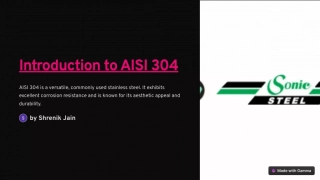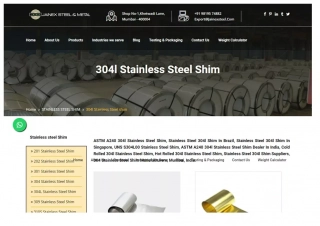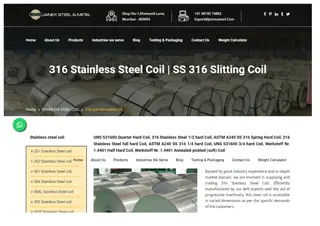
Stainless Steel Industry Adapts to Digital Transformation Trends
Stainless Steel Market By Type (Austenitic Stainless Steels, Martensitic Stainless Steels, etc), By Application (Automotive, Construction, and Heavy Industries), By Grade (200, 300, and 400 Series, Duplex Series), By Region and Companies - Industry S
Download Presentation

Please find below an Image/Link to download the presentation.
The content on the website is provided AS IS for your information and personal use only. It may not be sold, licensed, or shared on other websites without obtaining consent from the author. Download presentation by click this link. If you encounter any issues during the download, it is possible that the publisher has removed the file from their server.
E N D
Presentation Transcript
Stainless Steel Market size is expected to be worth around USD 264 billion by 2032 from USD 131.5 billion in 2022, growing at a CAGR of 7.4% during the forecast period 2023 to 2032. The stainless steel market encompasses the production, distribution, and utilization of stainless steel, a versatile family of alloy steels with a chromium content ranging from 10 to 30%. This chromium content, along with other elements like nickel, molybdenum, titanium, aluminum, niobium, copper, nitrogen, sulfur, or selenium, enhances oxidation resistance, corrosion resistance in specific environments, and imparts unique properties. The production process involves melting the steel in an electric arc or basic oxygen furnace, followed by polishing in various vessels to reduce carbon content. Stainless steel's unique combination of strength, aesthetic appeal, durability, low maintenance costs, and corrosion resistance gives it a competitive edge over carbon steel. These attributes, along with rising demand and increased application penetration, are anticipated to propel the market's expansion. Investments in both residential and industrial sectors are expected to further boost the market response for stainless steel, solidifying its crucial role in modern infrastructure and manufacturing. Download a sample report in MINUTES@ https://market.us/report/stainless-steel-market/request-sample/ Key Market Segments Based on Type
Austenitic Stainless Steels Martensitic Stainless Steels Ferritic Stainless Steels Precipitation Hard Stainless Steel Based on Application Automotive and Transportation Building and Construction Heavy Industries Based on Grades 200 Series 300 Series 400 Series Duplex Series Type Analysis: The austenitic stainless steel segment dominates the market due to its superior strength, durability, and corrosion resistance. Its aesthetic appeal, ease of manufacturing, and environmental friendliness make it a preferred choice in architecture, automotive, and various other industries. Application Analysis: The automotive and transportation segment leads in stainless steel applications, driven by the need for lightweight, durable, and corrosion-resistant materials. Stainless steel's exceptional mechanical properties, weldability, and formability make it ideal for manufacturing automotive components and parts. Grade Analysis:
The duplex series stainless steel segment is dominant, known for combining the strength and corrosion resistance of both austenitic and ferritic phases. Widely used in automotive, aerospace, and construction industries, it offers high strength, durability, and excellent fatigue properties. Market Key Players Acerinox S.A Aperam Stainless Steel Acre lot Mittal Baosteel Group Jindal Stainless Nippon Steel Corporation Outolkumpu POSCO Yieh United Steel Corporation ThyssenKrupp Stainless GmbH AK Steel Corporation JFE Steel Corpo. Other Key Players Drivers: Rapid industrialization and the growth of the automotive and construction industries are key drivers of the stainless steel market. Stainless steel s high anti-resistance, strength, and heating properties make it ideal for automotive components, seat belt clips, and building materials. Its expanding use in chemical, petrochemical, oil and gas, food and beverage, and power generation industries further propels market growth. Restraints: The stainless steel market faces challenges due to the increasing use of carbon fibers in the automotive industry, driven by their lightweight, high strength, and load-bearing capacities. The availability of alternative products such as aluminum, galvanized steel, and carbon steel also
limits the adoption of stainless steel. Additionally, stainless steel's lack of water resistance and relatively heavy weight are significant drawbacks impacting its market growth. Opportunities: The growing investment in research and development by manufacturers has led to the creation of advanced methods for enhancing the properties of stainless steel, presenting lucrative opportunities for market participants. The adoption of innovative technologies such as Building Information Management (BIM) and the use of novel materials and processes are expected to further drive market growth. Challenges: The stainless steel market must address the challenge of competing with lighter and more versatile materials like carbon fibers, which are increasingly preferred in industries such as automotive. Additionally, the heavy weight and limited water resistance of stainless steel pose significant challenges that could hinder its market penetration.






















